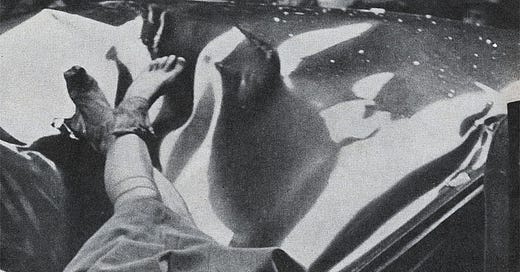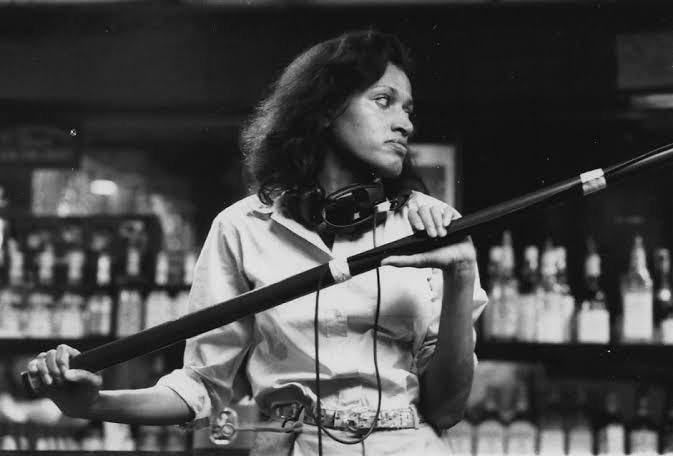The Feminine Grotesque No.1: Killing Time (1979) and the Black Madwoman
Where is the black madwoman in American cinema? What does she have to say about suicidal ideation, the way femininity is linked to death, and the personal narratives we rely on to survive?

“Killing Time” (1979)
Written, directed, and starring Fronza Woods
Runtime: About 8 minutes
The black & white short film is currently streaming on Criterion Channel until the end of this month!
After I published my last newsletter, I became rather unmoored by a series of emotional and material sorrows, including my mother’s complicated health issues which highlighted the fractures in our already strained relationship. I tumbled into an intense suicidal-depressive episode that crept close to two weeks long. I’m trudging my way to solid ground now. In the process of trying not to plan my own suicide, I started to think about suicide on a cultural level through the lens of female madness. This is a subject that lights my soul aflame. I moved away from writing all that personally about my mental health struggles — and the immense amount of growth I’ve made in the last few years navigating some heavy dynamics and events including death, reconnections, lost friendships, and a heinous relationship I am thankful every day for the last 10 months that I was strong enough to get the hell out of.
My previous suicide attempts were bound to the sartorial. I had outfits in mind for each one. Which is why when I first watched the 1979 short film Killing Time, I felt a sense of kinship. When I hear conversations about representation and the need to see oneself on-screen in hyper-specific ways, I bristle. This isn’t why I go to film. I am drawn to cinema to feel, to see worlds and lives unlike my own, to consider the bruising complexities of being alive. When I can’t decide what film to watch on a given evening I ask myself, what life do I want to step into? What vibe do I want to set? More than a portal into my own experiences with suicidal ideation and active planning, Killing Time is a masterwork of off-kilter humor and startling humanity. Clocking in just shy of nine minutes, the short film is a window into a woman’s mind beset by the desire to die. Starring its own writer-director Fronza Woods, Killing Time speaks truths into the cinematic silence of the black madwoman. It’s all the more startling that Woods tosses aside the need to make this woman a spectacle — which is often a profound tension in what I like to call the feminine grotesque.
The Feminine Grotesque is an ethos, sub-genre, and outlook I have spent the last decade defining and exploring. It acts as a guiding principle for this monthly(ish) column. For my Letterboxd list of examples, I defined it as:
“The emotional, social and psychological problems that are specifically connected to the character’s sense of womanhood which provides the meat and gristle of this genre. The questions of women’s pictures turn on their pretty heads in The Feminine Grotesque. The tools of beauty — physicality, dress, makeup — become weapons that wound as much as they empower.
Like women’s pictures, The Feminine Grotesque offers visual liberation from the confining strictures of the patriarchy. No matter how temporary, women are able to see themselves as bold, defiant, vulnerable, sexually realized, selfish, ambitious and hopeful. The films of The Feminine Grotesque obsess over female desire and subjectivity, but even with this strong feminist impulse, the genre is often [marred] by endings that show these women integrating themselves but lacking any hope for a future. In cinema, like in life, it often feels like there is rarely hope for the madwoman.
Madwoman (noun)
A woman who is mentally ill.
A woman with a transgressive place in society because of her anger, sexuality and/or refusal to play by the rules.
A woman ruled by her passions. (see: Taylor, Elizabeth).
A woman of fire and music. (see: Davis, Bette in All About Eve).”
It is in this obsessive taxonomy of female madness that I have gathered and nurtured the stories of women whose madness has often led to the culture around them forsaking their humanity for crude projections. This is especially true when it comes to the story behind the picture that hovers atop this newsletter known as “The Most Beautiful Suicide”.
When Evelyn McHale jumped from the observation deck of the Empire State Building on May 1st, 1947, the 23-year old engaged bookkeeper had no idea she would become enshrined in a pantheon of madness in which her humanity would be stripped away for the iconography her body could provide. Less than five minutes after McHale cleared the setbacks and landed on the roof of a United Nations limousine that would become her deathbed, cabbie and photography student Robert Wiles cut through the crowd to take the photograph that time and interest would enshrine as iconic. “The Most Beautiful Suicide” would reach far beyond the pages of the Life magazine issue it was published within. Andy Warhol’s 1962 turquoise-sheened reprinting. Music videos from David Bowie and Taylor Swift. Glossy fashion advertisements. McHale is reappropriated, reconsidered, remixed, and cast aside as a vessel for an iconography that has existed long before her fatal plunge.




